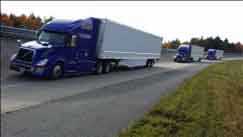With all the news about autonomous trucks, the industry may be a long way off from seeing commercialization of that type of technology, with many regulatory and safety hurdles still to be overcome.
What may not be so far away, however, is the use of platooning technology, in which a group of typically three trucks travel together – with drivers – but the trailing two trucks automatically moving in tandem with the truck in front of them. This allows those trailing trucks to travel at much closer distances to the trailer ahead, improving mileage through reduced wind resistance. It can also have the effect of reducing trucks on the highways.
Supply Chain Digest Says... |
 |
| Trentacoste said two-truck platoon systems could be commercially available as early as next year, for example, though others offered less aggressive timelines. |
 |
What do you say? |
| Click here to send us your comments |
 |
| Click here to see reader feedback |
|
|
There have been several demonstrations of platooning technology both in the US and Europe, the latest being last week in Virginia, where a trio of Volvo trucks put on a display using a control system from Peloton Technologies. University of California researchers are also part of the Volvo team.
The Federal Highway Administration led the demonstration on Sept. 14. The agency oversaw a successful series of two-truck platoons in Texas last summer.
This latest test was conducted over an 8-mile route on a state highway. The closest trailing distance between trucks in one of the test drives was 45 to 50 feet with the trucks travelling at 55 mph, which translate into a following gap of just 0.6 second.
This synchronization is achieved with systems on all three trucks that communicate with each other.
"This is important for highway efficiency," said Michael Trentacoste, director of FHWA's Office of Research, Development and Technology, said during the demonstration.
Trentacoste also noted that since increasing the number of lane-miles on US highways is a slow and expensive proposition, having trucks moving closer together has a similar effect to taking trucks off the road in terms of congestion.
Similarly, acting Federal Highway Administrator Brandye Hendrickson said that "These new technologies have the ability to increase capacity on our highways and make freight transportation more efficient. With innovations like these, we can get more out of the highway system we already have, relieve traffic congestion and reduce costs to the freight industry."
The test in Virginia used partially automated trucks that handle acceleration, deceleration and braking, with professional drivers actively steering the trucks and able to step in if necessary in case of any problems.
(See More Below)
|
CATEGORY SPONSOR: SOFTEON |
|
|
| |
|
|
 The FHWA emphasized that the advanced technology that makes platooning possible is meant to supplement, not replace, the nation's commercial motor vehicle operators. That potential loss of driver jobs is a politically sensitive issue, which in fact led the House of Representatives to pass a bill that could help bring self-driving cars to market faster – but left out any help for autonomous trucks due to the jobs issue. A Senate version of the bill, however, may address trucks. The FHWA emphasized that the advanced technology that makes platooning possible is meant to supplement, not replace, the nation's commercial motor vehicle operators. That potential loss of driver jobs is a politically sensitive issue, which in fact led the House of Representatives to pass a bill that could help bring self-driving cars to market faster – but left out any help for autonomous trucks due to the jobs issue. A Senate version of the bill, however, may address trucks.
The technology may be very close to reality on the road. Trentacoste said two-truck platoon systems could be commercially available as early as next year, for example, though others offered less aggressive timelines.
The demonstrationin Virginai included a so-called "cut-in" segment, in which a passenger car moves into the gap between two of the three trucks. The radar mounted on the Volvo trucks determined a following distance so the trucks could travel safely even though a car had joined the train.
However, the demonstration did not include a "stomp-the-brakes-hard" test, which apparently for now would require the highway be closed to any other traffic in the area.
There are some caveats to all this. The fuel-efficiency gains are only achieved in long-distance, highway-speed trips. And there are questions about whether all three trucks in a platoon would have to be from the same carrier, all using the exact same system, limiting its applicability.
Are you bullish on platooning technology? Why or why not? Let us know your thoughts at the Feedback section below.
Your Comments/Feedback
|